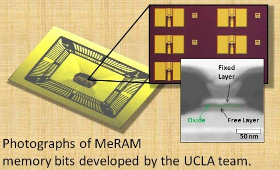UCLA created a new type of magnetoresistive memory.
 Magnetoresistive memory (MRAM) is one of the “hottest” areas of research for new types of memory. In the future, it can surpass all existing types of memory in all characteristics. The MRAM cells are comparable in speed with SRAM memory, which is used in the processor cache, and in cell density, with DRAM. The MRAM memory is non-volatile and much more economical and more durable than flash memory.
Magnetoresistive memory (MRAM) is one of the “hottest” areas of research for new types of memory. In the future, it can surpass all existing types of memory in all characteristics. The MRAM cells are comparable in speed with SRAM memory, which is used in the processor cache, and in cell density, with DRAM. The MRAM memory is non-volatile and much more economical and more durable than flash memory.The information in the MRAM cells is stored in two ferromagnetic layers separated by a thin layer of dielectric. One of the layers is a permanent magnet, the direction of the magnetic field of the second layer can vary. To change the magnetic field, a current is passed through the cell. The electrical resistance of the cell (tunneling magnetoresistance effect) depends on the mutual orientation of the fields in these layers. By measuring this resistance, you can count the bits stored in the cell. Today, the most advanced recording method uses the spin-transfer torque effect - “polarized” electrons, passing through a ferromagnetic layer, help rotate the magnetic field in a certain direction, resulting in much less current being required, and the cells can be smaller .
Researchers at the University of California at Los Angeles (UCLA) have found a way to switch the magnetic field using electrical voltage rather than current, which can result in energy consumption from 10 to 1000 times, respectively, reducing the heating of cells during recording and increasing their density on crystal 5 times. They call this type of memory MeRAM (magnetoelectric random access memory)
The technology of making a new type of memory is very close to that used for memory with spin-moment transfer (STT-RAM). Since the first experimental batches of STT-RAM are already in production, it is possible that we will wait for MeRAM quite soon.
')
The massive use of magnetoresistive memory can open up completely new possibilities. Unlike dynamic memory, it is non-volatile and requires much less electricity to record than flash memory. On its basis, you can create subminiature and almost non-electricity devices, or ordinary computers, always ready to work, with almost zero download time.
Source: https://habr.com/ru/post/163749/
All Articles